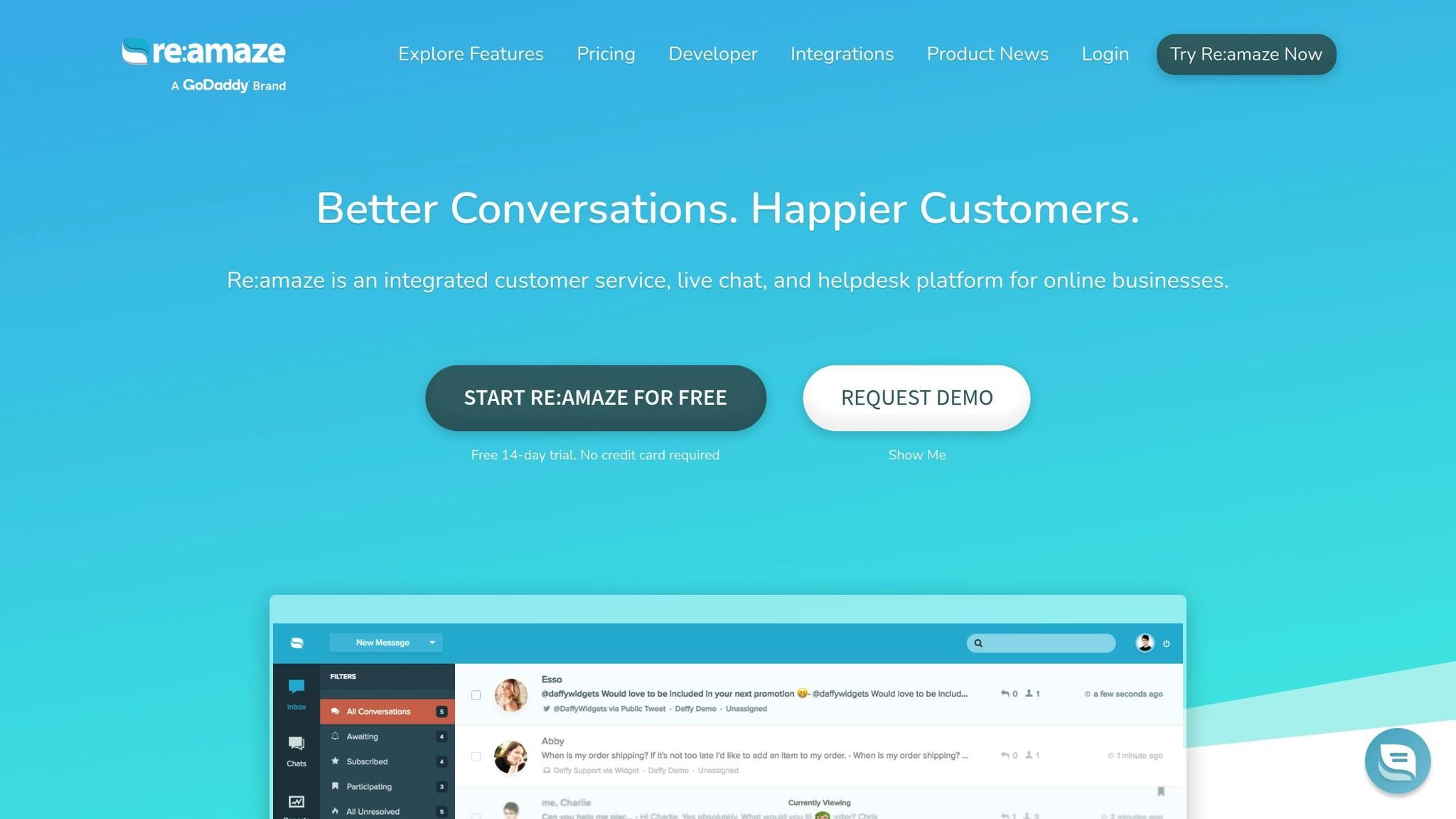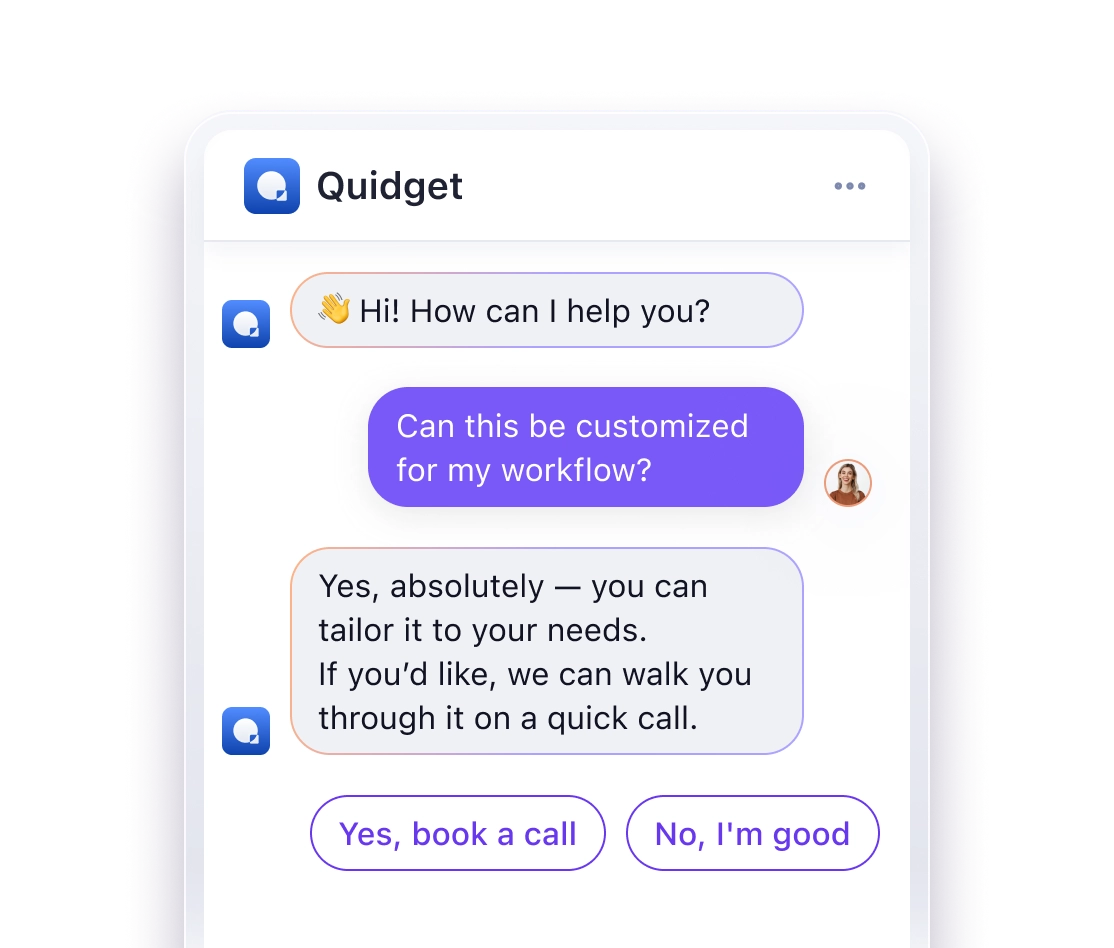Best AI Virtual Assistants for E-Commerce: Automate Support, Sales & Shopping Help
AI virtual assistants are transforming e-commerce by automating customer support, driving sales, and enhancing the shopping experience. Here’s what they do:
- Handle Routine Tasks: Automate up to 80% of customer queries, like order tracking and FAQs.
- Boost Efficiency: Free up human agents for complex issues.
- Personalized Recommendations: Suggest products based on browsing and purchase history.
- Recover Sales: Send cart abandonment reminders via email or SMS.
- 24/7 Support: Provide around-the-clock assistance across multiple channels.
- Global Reach: Support over 45 languages for international customers.
Quick Overview of Top Tools:
- Quidget: No-code platform with fast setup, multilingual support, and seamless integrations.
- Shopify Inbox: Ties customer chats directly to Shopify orders for context.
- Re:amaze: Combines AI chat with analytics and workflow automation.
AI assistants improve customer satisfaction while reducing costs. Start by choosing a tool, uploading store data, and tracking performance to ensure success.
Every Ecommerce Store Owner Needs a Chatbot in 2025!
Understanding E-Commerce AI Virtual Assistants
AI virtual assistants in e-commerce go beyond basic chatbots, using machine learning to deliver smarter, evolving customer interactions. These tools are designed to handle a variety of tasks, creating a new standard for online customer service.
Key Features
Today’s e-commerce AI assistants bring advanced tools to the table, reshaping how businesses interact with customers:
- Natural Language Processing (NLP): They engage in conversations that feel natural, moving away from outdated keyword-based responses.
- Multi-Channel Support: Whether it’s a website, mobile app, or messaging platform, they deliver consistent service across all channels.
- Always Available: Unlike human agents, AI assistants are ready to assist 24/7, ensuring no customer query goes unanswered.
- Lead Qualification: They can identify potential customers and direct the most promising leads to sales teams.
- Seamless Integration: These assistants connect directly with platforms like Shopify, Zendesk, and WhatsApp, ensuring smooth operations and data sharing.
These features are backed by a robust technical foundation that ensures efficiency and adaptability.
Technical Overview
AI assistants rely on advanced technology to adapt and improve with every interaction. They process and learn from a variety of data sources, including:
- Customer interaction history
- Product catalogs
- FAQ pages
- Website content
- Order details
Here are some of the standout technical capabilities:
- Contextual Understanding: By analyzing entire conversation histories, the AI provides more accurate and relevant responses.
- Smart Routing: When a question is too complex, the system transfers the case to a human agent, along with the full chat history for context.
- Multilingual Communication: They can assist customers in multiple languages, making them effective for global audiences.
With every customer interaction, the system refines its responses, learning to handle more complex queries over time. For e-commerce businesses, these virtual assistants serve as a reliable first point of contact, managing everything from simple product inquiries to intricate order issues – all while maintaining consistent, high-quality service.
Common Applications in Online Stores
AI assistants bring advanced features like natural language processing and multi-channel support to the table, automating essential e-commerce tasks that drive sales and keep customers happy.
Product Suggestions
AI assistants are great at offering personalized product recommendations by studying a customer’s past purchases and browsing habits. They can even engage shoppers in a conversation to better understand their preferences.
- Review Previous Purchases: Suggest products that complement items already bought.
- Monitor Browsing Behavior: Spot which products capture the shopper’s attention.
On top of recommendations, these tools help recover missed sales opportunities by reconnecting with potential buyers.
Cart Recovery
When shoppers abandon their carts, AI assistants step in with automated email or SMS reminders. These timely messages encourage customers to return and complete their purchases.
While recovering carts is a key sales strategy, keeping customers informed about their orders also plays a big role in maintaining satisfaction.
Order Updates
AI assistants simplify order tracking by offering instant updates, ensuring customers stay informed at every step:
- Real-Time Shipping Notifications: Provide up-to-the-minute details about shipments.
- Delay Alerts: Notify customers about potential delivery issues.
For more complex questions, like detailed delivery estimates or reasons for delays, AI assistants effortlessly hand off the conversation to human support staff. This approach not only improves the customer experience but also reduces the workload for support teams.
Leading AI Assistant Tools
AI platforms are reshaping how businesses handle customer interactions and improve efficiency.
Quidget

Quidget is a no-code AI platform designed to enhance support and sales processes.
Key features include:
- Fast Setup: Get started in just 3 minutes and automate up to 80% of inquiries
- Multilingual Capabilities: Supports over 45 languages for global reach
- Smart Escalation: Transfers complex issues to human agents seamlessly
- Easy Integration: Works with popular tools like Shopify and WooCommerce
"Quidget is a no-code AI Agent platform that helps businesses automate frontline support, sales, and internal processes. It learns from your content, including FAQs, your website, and uploaded documents, to provide instant, human-like responses while handing off complex cases to your team."
– Quidget Website
Other tools focus on simplifying communication and integrating with existing systems.
Shopify Inbox

Shopify Inbox connects customer conversations directly to your Shopify store, offering:
- Seamless integration with Shopify order data
- Links between chats and customer orders for better context
- Mobile access for on-the-go responses
- Automated replies to handle basic queries
Now, let’s look at a tool that combines messaging with advanced analytics.
Re:amaze

Re:amaze blends AI-powered chat features with a robust set of customer service tools, making it ideal for growing e-commerce businesses. Highlights include:
- A single interface that centralizes all customer communications
- A built-in knowledge base for easy self-service options
- Custom workflows to automate repetitive tasks
- An analytics dashboard to monitor customer interactions and performance
These tools provide various ways to improve e-commerce support and boost sales.
sbb-itb-58cc2bf
Setup Guide for Online Stores
Follow this guide to get your AI virtual assistant up and running smoothly for your online store.
1. Select Your AI Tool
Picking the right AI assistant depends on your store’s specific needs. Here’s what to consider:
Platform Compatibility
Make sure the AI assistant works seamlessly with your e-commerce platform. For example, if you use Shopify or WooCommerce, check for native integration options.
Features You Need
Identify the features that align with your business goals, such as:
- Automated customer support
- Product recommendations
- Order tracking
- Multi-language capabilities for international customers
Technical Skills
Choose a tool that fits your technical expertise. If you want an easy setup, go for no-code solutions that allow quick deployment without requiring advanced skills.
Once you’ve chosen your AI tool, the next step is to provide it with accurate store data.
2. Input Store Data
To make your AI assistant effective, it needs accurate and comprehensive data about your store.
Key Data to Include
- Product catalog
- Frequently asked questions (FAQs)
- Return and shipping policies
- Common customer inquiries
- Website content
Training the AI
Start with your most critical information. Upload your FAQs and knowledge base to help the AI handle common questions effectively. This initial setup can automate a large portion of customer interactions.
Language Settings
If your store serves customers worldwide, enable multilingual support. Many platforms offer support for over 45 languages, making it easier to communicate with a global audience without additional effort.
After inputting your data, focus on monitoring and refining the assistant’s performance.
3. Track Results
Even the best-trained assistant needs regular performance checks to ensure it’s meeting your expectations.
Metrics to Watch
- Response accuracy
- Customer satisfaction scores
- Time taken to resolve queries
- Percentage of automated responses
- Frequency of escalation to human agents
Improving Performance
Review chat transcripts regularly to identify problem areas. Update training data and tweak response templates to address any issues.
Useful Integrations
Connect your AI assistant to your help desk software, set up automated workflows for repetitive tasks, enable smart escalation for complex queries, and define clear protocols for handing off to human agents.
Benefits and Limitations
Knowing the strengths and challenges of AI virtual assistants can help you set realistic goals for your e-commerce business.
Key Benefits
24/7 Availability:
AI assistants work around the clock, ensuring customers can always get support – even during off-hours – leading to higher satisfaction.
Lower Operating Costs:
By automating up to 80% of routine customer inquiries, AI assistants help cut costs and allow human agents to focus on more complex tasks.
Multilingual Capabilities:
They can communicate in over 45 languages, making it easier to serve a global customer base without hiring additional multilingual staff.
Consistent Responses:
AI ensures uniform answers to frequently asked questions, reducing the risk of miscommunication and maintaining your brand’s voice.
Lead Qualification:
Automatically identifies and qualifies potential leads, providing a steady stream of prospects for your sales team.
While these benefits are substantial, it’s important to recognize the limitations of AI assistants.
Current Limitations
Several factors can impact their effectiveness:
Handling Complex Issues:
AI may struggle with intricate problems that require human intuition and judgment.
Initial Setup Effort:
Setting up an AI assistant involves significant work, such as curating a knowledge base and customizing it to your business needs.
Supervision During Rollout:
When first deployed, AI tools often need close monitoring to ensure they function as intended.
Context Limitations:
AI can miss subtle context clues, especially in complicated or highly specific scenarios.
Reliance on Data and Systems:
Their performance depends heavily on access to quality data and seamless integration with your existing systems.
For the best results, many businesses combine AI tools with human expertise, blending the efficiency of automation with the personal touch of skilled agents.
Conclusion
AI virtual assistants are changing the game for e-commerce by improving customer service and cutting down on operational costs. These tools handle routine questions efficiently, offering personalized support that grows alongside your business.
But they don’t just stop at answering questions. AI assistants can manage tasks like product recommendations, cart recovery, and order tracking around the clock. They also provide support in multiple languages and across time zones, making them a key asset for businesses looking to expand globally.
As the technology advances, these systems are becoming even better at understanding customer needs, processing natural language, and integrating smoothly with e-commerce platforms.
To get started, set clear goals for how you want to use AI. Begin by automating common customer inquiries and basic tasks to ensure smooth implementation while maintaining high service standards.
The key to success is balancing AI automation with human expertise. Let AI handle repetitive tasks, freeing up your team to tackle more complex issues that require a personal touch and deeper understanding.
As you refine your approach, think about how AI could reshape your customer service strategy. Ready to see the difference? Start your 7-day free trial with Quidget today and discover how AI can elevate your customer interactions while keeping the human connection intact.
FAQs
How can AI virtual assistants enhance customer satisfaction and cut costs in e-commerce?
AI virtual assistants enhance customer satisfaction by providing instant, 24/7 support, ensuring customers get quick answers to their questions anytime. They can handle tasks like order tracking, product recommendations, and abandoned cart reminders, creating a seamless shopping experience.
Additionally, they help reduce operational costs by automating repetitive tasks, such as answering FAQs and managing email or SMS outreach. For complex issues, they efficiently route customers to human agents, saving time and resources while maintaining high service quality.
How do I set up an AI virtual assistant for my online store?
Setting up an AI virtual assistant for your online store is easier than you might think. Start by selecting a platform that offers a no-code solution, allowing you to build and deploy your assistant without technical expertise. Once you’ve chosen a platform, train the AI using your business data, such as FAQs, product details, and website content. This ensures the assistant can provide accurate and helpful responses to your customers.
Most platforms streamline the process, so you can have your AI assistant up and running in just a few minutes. From there, it can handle tasks like answering customer questions, sending order updates, and even recommending products, all while operating 24/7 to enhance your store’s efficiency and customer experience.
How do AI virtual assistants provide multilingual support and maintain consistent service across languages?
AI virtual assistants use advanced natural language processing (NLP) models to understand and respond in multiple languages. These models are trained on diverse linguistic datasets, allowing the assistant to detect the language a customer is using and reply accordingly.
To ensure consistent service, AI tools often rely on machine translation and pre-trained language models that standardize responses across languages. This helps maintain tone, accuracy, and brand voice, regardless of the language being used. Additionally, businesses can customize responses to align with cultural nuances and customer expectations in different regions.



